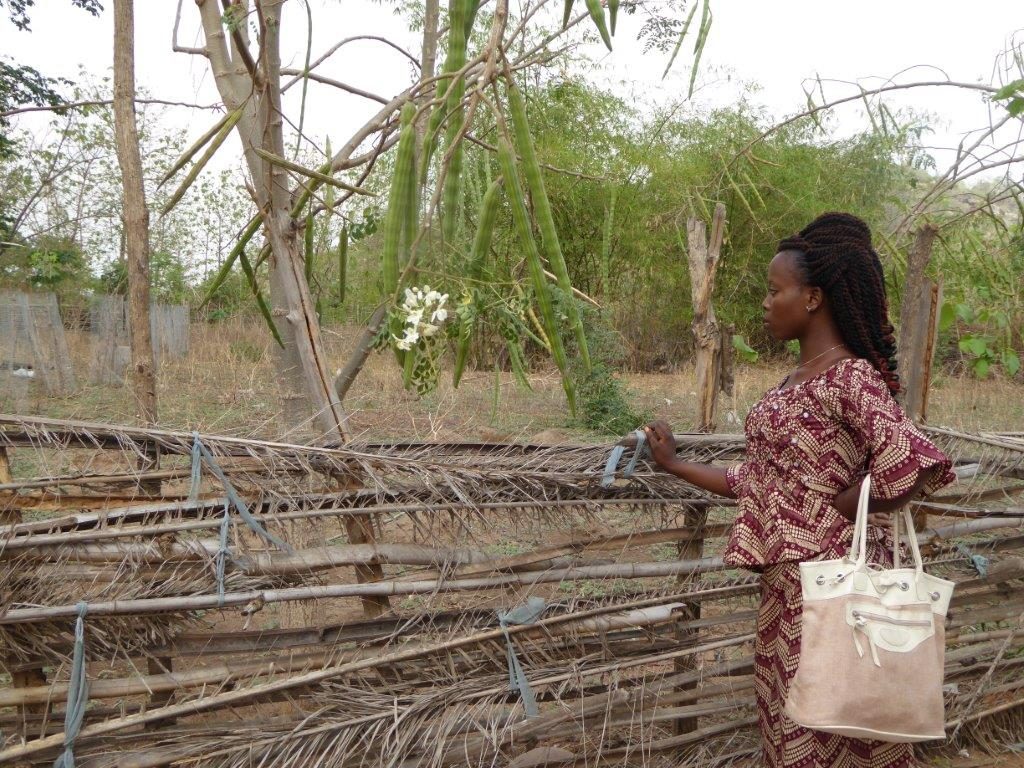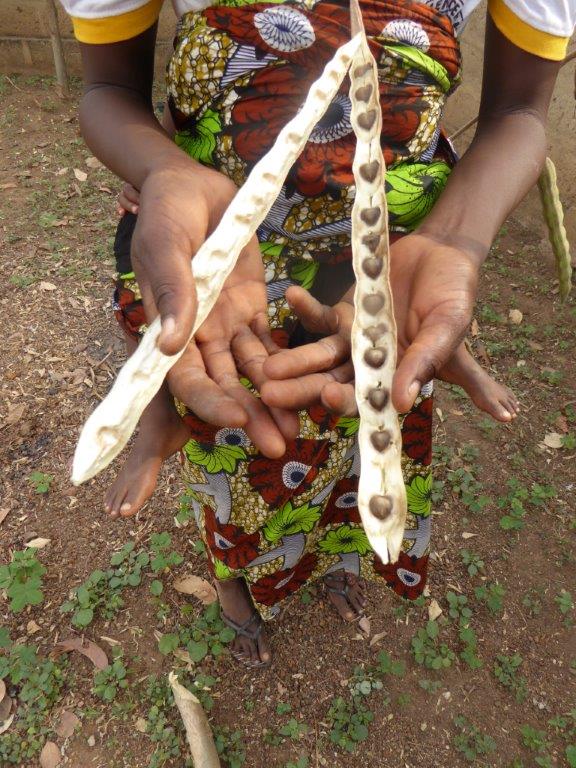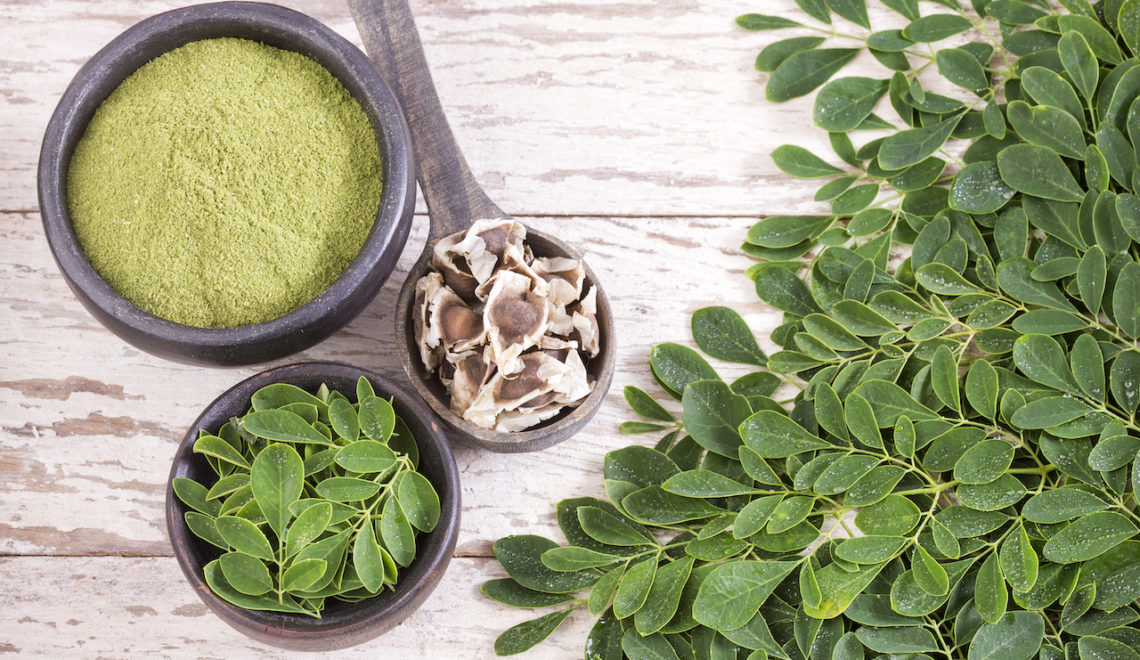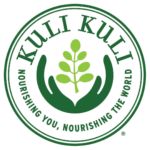While you may have only seen the word “moringa” in the last few years, how much do you know about it? This plant from “the miracle tree” has been used by cultures all over the world for thousands of years. But what are the parts of a moringa tree and what can they be used for?
Julie Curtis, sister of Kuli Kuli CEO Lisa Curtis, works as a Peace Corps volunteer with female moringa farmers in Benin, West Africa. She works hard to help build a moringa processing center for the women’s cooperative she’s involved with.
Here’s Julie’s unique perspective on the tree she works with every day. We hope you enjoy!
What are the parts of a moringa tree and their benefits?
Although if intensely cultivated moringa can resemble a bush, under normal circumstances, moringa is one very miraculous, beautiful tree. It is native to India and is used in developing nations, including my current home of Benin, West Africa.

Although Kuli Kuli focuses on the most nutrient dense part of the tree, the leaves, every single part of the tree from the seeds, roots, trunk, flowers, and leaves, has nutritional, medicinal and technical benefits.
In this article, we’ll review the main benefits from each part of the moringa tree. Kuli Kuli also summarizes the 10 Reasons to Eat Moringa Everyday in one of their latest articles.
Ready to learn more about this supergreen? We’ll explore, part by part, how the moringa tree earned its name “the miracle tree.”
The Seeds

When asked by Beninese what a “yovo” (white person) like myself is doing living here I tell them I am here to work with moringa. Majority of the people know what moringa is and about half of those who do will proceed to tell me how they pop a seed every morning in order to lose weight, cure their malaria or give them magic powers. There are some misconceptions floating around in regards to the seed.
Moringa is widely known in India as the drumstick tree due to the common practice of harvesting the long seed pods before they are fully developed and preparing them similar to as you could with green beans.
The seeds, once developed, can be dried and planted or eaten as is, as is the case in Benin. Although eating a seed every morning may not give you superpowers (I tried), it does have similar benefits to eating the leaves.
The Roots
The roots of the moringa tree have been used for their therapeutic properties dating as far back as the early Roman, Greek and Egyptian times. Although the roots actually have the highest nutrient quantities than any other part of the tree, I do not advise digging up the roots and making a hearty stew quite yet. When consumed in large enough quantities, the toxins found in the root can paralyze the nervous system and cause death.
times. Although the roots actually have the highest nutrient quantities than any other part of the tree, I do not advise digging up the roots and making a hearty stew quite yet. When consumed in large enough quantities, the toxins found in the root can paralyze the nervous system and cause death.
That said, the threat of death does not stop people around the world from using moringa roots. Moringa roots are known for their antibiotic properties and are used to treat a variety of conditions such as asthma, digestive disorders, gastritis, inflammation and skin disorders. It is even used by women in the more rural parts of India as a form of permanent contraception.
The Trunk
Similar to the roots, the bark of the moringa tree has antibiotic properties. It is used to help treat everything from sexually transmitted diseases, gout, and even arthritis. Also similar to the roots, due to the high concentration of antibiotics, again, it can be dangerous if used inaccurately.
In Benin and in most countries where moringa grows, the bark is more commonly used as animal fodder and the trunk itself as fencing.
The Flowers

In many parts around the world, moringa flowers are considered a delicacy. Some remark their taste similar mushrooms and can be used in salads or fried and eaten on their own. It is also common practice to drink moringa flower tea.
In Haiti they say the tea helps cure the common cold. In the Ayurvedic practice, the moringa flowers either brewed into a strong medicinal tea or a pressed juice. This juice is used to treat urinary tract infections and as a supplement for breastfeeding women to increase lactation.
Kuli Kuli has a whole article on the Why Moringa is Good for Women, which explains more on this.
The Leaves
The most user-friendly and nutritious part of the tree is the leaves. Not to be fooled by their small size, moringa leaves are incredibly powerful as a nutritional supplement. Beninese generally make the leaves into a vegetable sauce coupled with their staple starch, a corn flour based mashed potato-like substance called ‘pate’.
The protein in moringa is on par with more expensive alternatives such as meat, fish, and eggs—protein sources many Beninese don’t often include in their diets due to cost.

About thirty years ago when moringa was first introduced to Benin it was seen as the “poor man’s food.” Those in rural villages were quicker to include the leafy green in their diets because it grew year round and paying for vegetables was not always an option.
Now that knowledge is spreading throughout the country the perception is shifting and people from all socioeconomic classes are starting to include either the fresh leaves or the powder in their diets.
I do not lose hope, little by little, “petit à petit,” the world will know the power of moringa.
Be sure to check out other articles on our blog and follow us @kulikulifoods for more!
Follow us @kulikulifoods or leave us a comment so we can see some of your favorite ways to enjoy the benefits of this miracle tree.











Very nice info piece on moringa benefits, Julie!
How do you know how much moringa is too much to ingest. I have Aggressive case of RA (Rheumatoid Arthritis) and it was suggested I try Moringa for relief with wery flare ups. I’m taking anti-inflammatory meds from my Rheumatologist that I feel are harming my condition more and really don’t help.
U can take around2 capsule as starter..if u still dont feel anything u can increase up to 3-5 depends on your need..try n error n drink lots of plain water when taking moringa.. i take moringa almost 7 years.. i eat 4/5 capsule pertake..
Thanks, how can someone used mornings for diabetes treatment?
Hi Oladele! Multiple studies suggest that moringa leaf powder can help to significantly reduce blood glucose levels, cholesterol, and increase glucose tolerance. We always recommend checking with your doctor for treatment, as we cannot give medical advice; adding moringa to your daily diet can be a great first step!
I have the same problem and have been taking one tablespoon of Moringa powder every morning for the past 4 years it works perfect no other meds. Just be sure to start slow and work your way up I started with 2 capsules a day for the first 2 days then went up by one capsule each day until I got to 5 capsules then switched to a full table spoon the powder is much less expensive than the capsules. But if you are on meds plz plz talk to your doctor before you start because taking moring along with certain meds is like double dosage and can be dangerous it is truly a miracle tree that has changed my life!
Am impressed with this muringa, I didn’t know anything about muringa but now I know. How can I get muringa?
Hello. Can you boil the bark n drink it?m
I really want to understand how moringa can be used in the treatment of epilepsy. What really is the process or preparation of it in epilepsy treatment?
I love the muringa trunk, it’s amazing, where can I find it here in Kenya?
Dear
Lisa Curtis.
I am from Pakistan, and want to grow moringa plant in my garden and use it personally
can you help me to do so.
I want few seeds for this from you.Can you send me.
I shall be obliged
I have been growing Moringa trees for three years and harvesting seeds to eat and to grow more trees. My trees grow to 10 feet in one year and over 20 feet in two years. They bloom and produce seeds. Me and my staff were eaingt a stem of leaves every day. Now we are eating two seeds a day. I have been told I can cut them back to head high and grow them like a hedge which makes it easier to harvest the seed pods. I am eager to learn all I can and share this incredible plant with the world.
I live on Ambergris Caye in Belize, Central America.
Very much informative. I am from Pakistan and want to tell Mr. Syed Younus Ali that Morning in Pakistan and India is called “Sohanjna” or “Saijan” tree. It’s leave,seeds, drumsticks, branches and roots are used by people in both the countries from very old period for food and treatment of joint pain. However, it’s muraclious properties have come to knowledge in very recent days.
Harriette Fisher…So excited to read your post that you live on Ambergris Caye. I live in Corozal Town. Where did you get your Moringa seeds/plants?
When you prune your trees, take your trunks,trim off leaving 1or3 branches. I use aloe as a root hormone.Put trunks 1 to 2 ft. in ground and they will grow.gives your trees a head start.Glenn from Florida
The more you cut the branches, the more it gives you more leaves. Moringga, we call it malunggay in my town in Bicol Philippines, we had it as fences around the yard and we cook the leaves almost every day as our vegetable. Nobody got sick in our family for over 20 yrs as I was growing. Now I am here in the US my friend gave me 6 seeds and I have two of that trees that gave me lots of leaves and I dehydrate them and bottled them. Now I shared and gave away specially to friends that have cancers and also to older members of my church to give them energy. Try to eat the moringga seed and then drink water afterwards, your taste is sweet. It’s like drinking sweet plain water without sugar!!! :-))
*injested
Harriette, I LOVE your positive attitude….May you, Harriette, and all beings ALWAYS BE HAPPY AND WELL AND PROSPER……Love part of the world you live in; help folks there grow and eat their own Moringa for good health…….yogi, tucson desert
I miss typed: should have been ‘Lovely part of the world you live in’ forgive me, Harriette, my mistake here….I am now 80 years old on 19 March 2021…..Older than God’s first dog, huh? Good to talk with you, Harriette, et. al..
Hi Harriette – I just got a pretty fresh and large (over 12″ long) pod from a Moringa tree that is grown by a store near me in Florida. I am curious as to the best way to remove the seeds from the pod to grow them. Do I need to wait for the pod to dry out? Or dry the seeds? Any suggestions would be greatly appreciated!
I want to know the benefits of moringa pods / drumsticks.
can we eat outer later of pods . it is very hard to digest I think.
Hey Abdul! I would not recommend eating the outer layer of the pods. As you said, they are very difficult to digest and they do have nearly as many nutrients as the seeds or the leaves of the moringa tree.
THE MORINGA INFO WAS VERY VERY HELPFUL
THANKS
I would like to get some live plants or seeds. Please let me know where I can purchase them ty jean
Very informative. Thank you for posting. I am growing moringa in my yard but lately something is eating whatever grows on it. Dragonflies, rabbits. Any suggestions?
Hi,
Im from srilanka, i would like to start my own new business from moringa products.
Can you please help me somebody cantact with me. I need a buyer.
I can export quality product, becouse sri lanka has very good moringa harvest.
Dear In Pakistan you can easily find lot of trees in multan , faislabad it’s local name SOHANJNA
What type of root system does the moringa tree have. I am interested in planting one in my backyard but hesitate to put it too close to my pool.
Harriette Fisher…So excited to read your post that you live on Ambergris Caye. I live in Corozal Town. Where did you get your Moringa seeds/plants?
I have just discovered that I have this tree and am amazed at the benefits, I have several health conditions I believe that eating this tree will ease. I would like to know more about using the Bark/turnk of the tree, can anyone advise me. I live in Cyprus, Thanks
Thank you so much for the information. Your dedication is so admirable and important to all.
Hi Lisa! Thank you! We’re glad to be a helpful resource 🙂
In my country, we can eat both leaves and flowers as you said, but we cew the roots just to cure diseases like flu and coughing
What is the dose if we use only leaves, stem & flowers. What is proccedure to prepare medicine ie., quantity of water boiling period if any. Shall we consume only leaf juice grinding in mixie Your early reply is awaited
Is it true that the roots of moringa tree is high in toxicity.
Hi Espee! Good question: moringa is a bioaccumulator, which means it absorbs all the nutrients in the soil which it is grown. That’s why at Kuli Kuli, we grow our moringa in nutrient rich & organic soil, so that our moringa displays the soil nutrients in it’s nutrient profile. We also only source the leaves from our moringa farms. In general, it’s good to make sure that you buy high-quality moringa from places that follow this practice! Hope this helps!
Hi Allie.
I’m looking for good seeds to plant Moringa but I am concerned about the quality of the seeds. Your point about the soil they use makes lots of sense. Is there a way I can buy the seeds fro planting from Kuli Kuli?
Hi David, thank you for reaching out! We don’t sell moringa seeds; however, it’s worth exploring farmer’s markets (when/if they are open), as there might be a local moringa farmer who has seeds. Depending on your location, of course. Moringa trees don’t need a lot of water and are wonderful, nourishing trees to plant 🙂
Hi Gururaj! Thank you for your comment and question. We cannot offer medical advice suggestions, but our blog does have a lot of ideas for moringa tea and dishes! We would recommend bringing additional questions with your doctor and working with them to build a plan that works best for you! Moringa offers a wide variety of benefits so we would recommend trying it see where it can fit into your diet.
Hi Allie. Congratulations on all you are doing. I think is great. Love reading the articles. I have never tried the Moringa leaves yet. Im definitely going to purchase some & start this month. My question are:
1. When you take it in capsules how many mg should capsules be? 2. On Amazon I see they sell packages of dry seeds to eat, would they be good to use for planting too?
3. We live in New Jersey, USA do Moringa leaves grow only in warm weather? Or in winter as well? Because I would like to plant & grow a tree. 4. Have you heard anything on Moringa being good for the liver? For people with cirrhosis of the liver?
Or any other liver problems?
5.Does Kulikuli sale Moringa capsules because I’m terrible when it comes to taste.
6.Do you know where I can get fresh leaves or purchase a tree from here in New Jersey? Thank you Allie I hope to hear from you soon in regards to my questions. God bless you I think you’re work is fascinating as well as helpful & truly needed. I can’t wait to start taking capsules & see how they help me with my thyroid, pre-diabetis & high cholesterol problems.
Also my digestion, and I hear is also good for loosing belly fat? Is the true or false?
I will definitely give feedback after 1-2 months of taking it.
can you send me the relevant information about the nutritional properties of moringa oleifera
Hi Mamta Kashyap! We have a lot of articles covering the nutritional properties of moringa – here’s our top article that explores the nutritional benefits! https://blog.kulikulifoods.com/2020/04/05/10-reasons-to-eat-moringa-everyday/
please send me the information about the nutritional properties of each plant part like leaves, root, bark, pods, seeds, trunk, flowers of Moringa oleifera
I planted moringa stem two years ago and it has grown and produced a lot of pods. I do eat the seeds and juice the leaves. It has been quite healthy.
Thank you for sharing have a great article.
Very helpful.
Thanks Laiza, of course!
We in Pakistan use to make curry of moringa flowers after boiling them in water 2 times to reducd its bitterness and then adding oil,spices and meat .it makes a very delicious recipe eaten with rice or simple home made bread
That sounds delicious!!
Is the moringa root can can be use to abort a baby?
Hi Dennis! When consumed in large enough quantities, the toxins found in the root can paralyze the nervous system and cause death. The moringa root is dangerous to use for medical treatments of any kind.
Pls can the root be soaked in alcohol drinks, and what is the health benefits???
Dear friends, I found this article delightfully helpful and informative…..Thank you so much…and BE HAPPY, everyone…….yogi
Great content!! So much informative content you produce high quality of content which is good for those people can possibly visit your site. It same as Haarlem Oil and Haarlem Oil for Horses made by French people in France. I love the journey of my research from this website. Hope you do more blog post here about health. Thank you and God bless!
Please I will like to know more about the health benefits of the seeds
My dear, l am 71 SBD since l got introduced to moringa, it has not only been my hospital it is gradually becoming my bank. I drink moringa tea every morning, eat at least four dried seeds a day. I eat the green leaves as salad or simply chew them if l too busy to prepare them. The green leaves can be cooked with meet or fish and palm oil to be served with rice (just the same way we eat cassava and potato leaves in Sierra Leone, Liberia and Guinea.
I also harvest the leaves, dehydrate, pound and sell in my community to make a living. Many people my locality have discovered Moringa usefulness and testifies the benefits and the market is opening up for me. Now lam dreaming of making the capsules and tablets because some of my customers complain of inconvenience of the method of absorbing moringa products. Besides, l harvest my raw material from neighbours who simply know very little about the moringa plants in their compounds as flowers. So l see a great future in having at least 10 acres of moringa farm, a processing plants for the powder, the oil, capsules and tablets, mainly to help poor people in saving their hospital bills. I have the land for this project in Sierra Leone but l need at least $10,000(USD) to do the plantings and set up the processing plant. Is there any way you can direct me to get financial and technical support, please?
well, its been almost 4 months since your request about help with starting a moranga farm and was just wondering how things are going now, as moranga is, indeed, a very useful plant…..can you please update us?
Please how is moringa tea is prepared and how many teaspoon is for a cup.
Hi Yeboah, We recommend taking 1 teaspoon to 1 tablespoon of moringa every day. You can also purchase moringa tea here: https://www.kulikulifoods.com/collections/teas/products/energizing-moringa-herbal-tea-bundle
Are there any clinical studies related to moringa and calming the amygdala that you can share? Is there a community of people using it that would be willing to share their experience (e.g long term use, did they have to increase the dose etc) I’ve had panic attacks and feeling nervousness and back/neck pain and tension headaches. I begun 3 days ago to take 1 teaspoon per day and feel like a different person. Unfortunately, the effects only last for about 8-10 hrs, therefore, the next morning, I have to take it again as I feel the nervousness coming back.